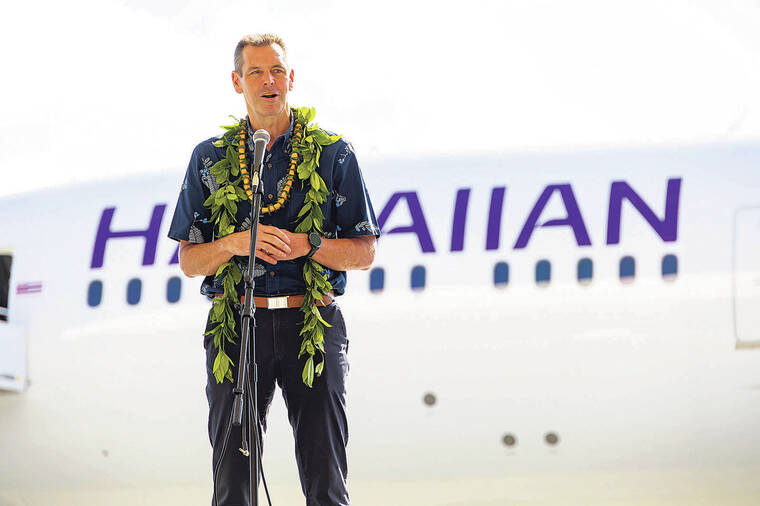HONOLULU — Hawaiian Holdings Inc., the parent company of Hawaiian Airlines, improved revenue and continued investments during the first quarter, but deepened losses as it grappled with rising operating costs and other headwinds while pursuing a merger with Alaska Airlines.
The state’s largest carrier reported a net loss of $2.65 a share, or $137.6 million, as compared with $98.3 million a year ago.
When adjusted for nonrecurring costs, the first-quarter loss came to $2.77 a share.
Hawaiian reported that its first-quarter revenue rose 5.7 percent to $645.57 million from $612.6 a million year ago.
The adjusted losses were larger than Wall Street expectations. Four analysts surveyed by Zacks Investment Research expected an average loss of $2.75 per share. However, Hawaiian’s revenue exceeded the $630.6 million average revenue expectation from three analysts surveyed by Zacks.
Hawaiian Airlines President and CEO Peter Ingram said during the earnings call, “In a quarter that featured some operational and commercial challenges, we made great progress on major initiatives and saw important improvement in some key operational metrics.
Early this year, a number of very important investments, ones like Starlink, our work for Amazon, and the 787 that we’ve been talking about on these calls for some time began to come to fruition.”
Hawaiian began Boeing 787-9 Dreamliner revenue service on April 15. The airline also has made Starlink inflight connectivity available free of charge on board all 18 A321neo aircraft.
“While some core parts of our network, notably Maui and Japan, have room to improve, the aggregate demand we’re seeing across our portfolio of routes is encouraging,” Ingram said.
“With the additions to our fleet, we are launching some new service in May, and the initial customer response to our flights between Salt Lake City and Honolulu, as well as between Sacramento and both Kona and Lihu‘e has been very encouraging.We’re also seeing good demand for additional seasonal frequencies that we’ve added to existing routes like Austin, Boston, Las Vegas, LAX and American Samoa.”
Ingram said the investments that Hawaiian is making and the initiatives that it is pursuing lay a strong foundation for financial resilience.
“There is a lot going on in 2024, with exciting new projects in addition to the pending merger,” he said. “My focus is on making sure that we don’t lose sight of the fundamentals: safety, running a great operation and sharing aloha with our guests, while we execute against a lot of initiatives.”
Hawaiian reported outstanding debt and finance lease obligations of $1.75 billion as of March 31. However, it also said it had capital resources of $897 million, including cash, cash equivalents and short-term investments. The carrier reported its liquidity at $1.15 billion, including an undrawn revolving credit facility of $235 million.
Hawaiian and Alaska need approval from the U.S. Department of Justice to complete their proposed merger, which was announced on Dec. 3. The boards of directors for both air carriers already have approved Alaska Airlines’ purchase of Hawaiian Airlines in a $1.9 billion deal, which includes $900 million in Hawaiian debt.
“While I’m sure the pending merger with Alaska Airlines is a topic of great interest, we don’t have anything material to share today beyond what we have already publicly disclosed,” Ingram said.
“We received shareholder approval for the combination in February and are working diligently to respond to the Department of Justice’s second request, which we received in early February. Our aim is to comply with that request as soon as possible, and we are making steady progress to that goal. “
Ingram added that on March 27, Hawaiian and Alaska disclosed a timing agreement with the DOJ in which “we agreed not to consummate the merger until 90 days after the date on which both parties have certified substantial compliance with the second request.”
It’s still unclear how the DOJ will rule given that the Biden administration has been more apt to scrutinize such mergers, as evidenced by the challenges that JetBlue and Spirit encountered when they tried to merge.
On March 4, JetBlue announced it had reached an agreement with Spirit to terminate their July 2022 merger agreement. That announcement came after U.S. District Judge William Young on Jan. 16 blocked JetBlue’s purchase of Spirit.
Young said the government had proved that the merger “would substantially lessen competition” and violated a century-old antitrust law.
A consumer antitrust lawsuit, which was filed April 15 in the U.S. District Court for Hawai‘i, is moving forward on behalf of eight passengers seeking to stop the acquisition of the 95-year-old Hawaiian Airlines by Alaska Airlines on the grounds that the merger would result in higher fares, fewer flights, job losses and cause injury to Hawai‘i’s economy.
•••
The Associated Press contributed to this report.





